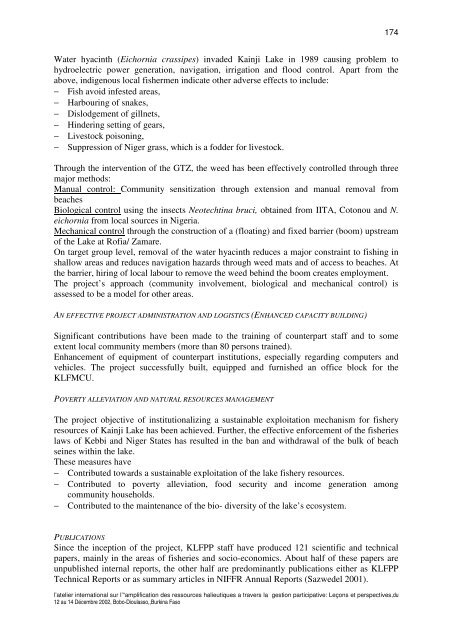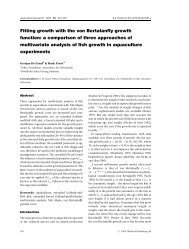RAPPORT GENERAL DE L'ATELIER ... - Nefisco.org
RAPPORT GENERAL DE L'ATELIER ... - Nefisco.org
RAPPORT GENERAL DE L'ATELIER ... - Nefisco.org
You also want an ePaper? Increase the reach of your titles
YUMPU automatically turns print PDFs into web optimized ePapers that Google loves.
174<br />
Water hyacinth (Eichornia crassipes) invaded Kainji Lake in 1989 causing problem to<br />
hydroelectric power generation, navigation, irrigation and flood control. Apart from the<br />
above, indigenous local fishermen indicate other adverse effects to include:<br />
− Fish avoid infested areas,<br />
− Harbouring of snakes,<br />
− Dislodgement of gillnets,<br />
− Hindering setting of gears,<br />
− Livestock poisoning,<br />
− Suppression of Niger grass, which is a fodder for livestock.<br />
Through the intervention of the GTZ, the weed has been effectively controlled through three<br />
major methods:<br />
Manual control: Community sensitization through extension and manual removal from<br />
beaches<br />
Biological control using the insects Neotechtina bruci, obtained from IITA, Cotonou and N.<br />
eichornia from local sources in Nigeria.<br />
Mechanical control through the construction of a (floating) and fixed barrier (boom) upstream<br />
of the Lake at Rofia/ Zamare.<br />
On target group level, removal of the water hyacinth reduces a major constraint to fishing in<br />
shallow areas and reduces navigation hazards through weed mats and of access to beaches. At<br />
the barrier, hiring of local labour to remove the weed behind the boom creates employment.<br />
The project’s approach (community involvement, biological and mechanical control) is<br />
assessed to be a model for other areas.<br />
AN EFFECTIVE PROJECT ADMINISTRATION AND LOGISTICS (ENHANCED CAPACITY BUILDING)<br />
Significant contributions have been made to the training of counterpart staff and to some<br />
extent local community members (more than 80 persons trained).<br />
Enhancement of equipment of counterpart institutions, especially regarding computers and<br />
vehicles. The project successfully built, equipped and furnished an office block for the<br />
KLFMCU.<br />
POVERTY ALLEVIATION AND NATURAL RESOURCES MANAGEMENT<br />
The project objective of institutionalizing a sustainable exploitation mechanism for fishery<br />
resources of Kainji Lake has been achieved. Further, the effective enforcement of the fisheries<br />
laws of Kebbi and Niger States has resulted in the ban and withdrawal of the bulk of beach<br />
seines within the lake.<br />
These measures have<br />
− Contributed towards a sustainable exploitation of the lake fishery resources.<br />
− Contributed to poverty alleviation, food security and income generation among<br />
community households.<br />
− Contributed to the maintenance of the bio- diversity of the lake’s ecosystem.<br />
PUBLICATIONS<br />
Since the inception of the project, KLFPP staff have produced 121 scientific and technical<br />
papers, mainly in the areas of fisheries and socio-economics. About half of these papers are<br />
unpublished internal reports, the other half are predominantly publications either as KLFPP<br />
Technical Reports or as summary articles in NIFFR Annual Reports (Sazwedel 2001).<br />
l’atelier international sur l’“amplification des ressources halieutiques a travers la gestion participative: Leçons et perspectives,du<br />
12 au 14 Décembre 2002, Bobo-Dioulasso,,Burkina Faso



